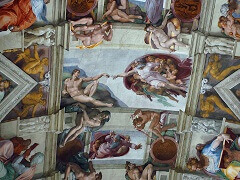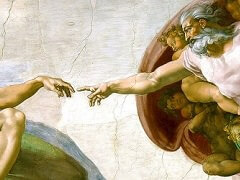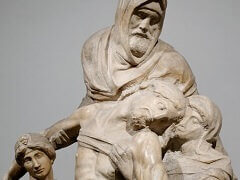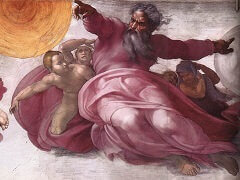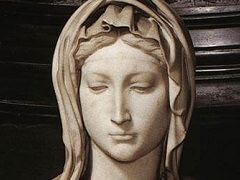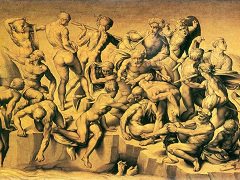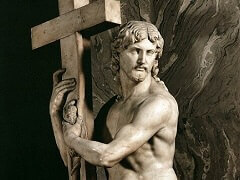Michelangelo Chronology
1475
MICHELANGELO BUONARROTI is born on March 6 in Caprese, a village near Florence, during his father's short term as mayor and local magistrate. The family soon returns to Florence. The infant Michelangelo is placed in the care of a
foster-mother in a town five miles from Florence. His mother dies when he is six.
1488
He quits school and signs up for an apprenticeship as a painter with Domenico Ghirlandaio.
1489
Michelangelo leaves Ghirlandaio's workshop and starts to study sculpture in the gardens of Lorenzo de' Medici. He lives at the ducal palace for three years in the company of the learned Humanists and sculpts his first works (marble reliefs):
Madonna of the Stairs and Battle of the Centaurs.
1492
Lorenzo de' Medici dies and Michelangelo goes back to live with his impoverished father but soon returns to the Medici palace, invited by Lorenzo's son Piero.
1494-1495
Florence rebels against the leadership of Piero. Michelangelo flees the city, goes to Bologna. There he sculpts three small statues for the tomb of San Domenico: St Petronius,
St Proculus and an Angel.
1496
Back in Florence he sculpts a Cupid (now lost) and sells it to the art dealer Baldassare del Milanese, who in turn sells it as an antique work to a Roman Cardinal.
1497
Michelangelo moves to Rome. To a banker-client he sells his first important work: the Bacchus and another Cupid, now lost. He makes his first trip to Carrara for marble.
1498-1499
He sculpts the Pieta for the French cardinal Jean de Billheres (also called Jean Villier de la Grolaie or Groslaye) but receives no other important commissions for nearly two years.
1501
Cardinal Piccolomini orders 15 statues for the Cathedral of Sienna. Michelangelo finishes four of them, begun by another sculptor, and adds one of his own, the ST. PETER, before abandoning the project.
1502
He returns to Florence, which has become a republic, and receives an order from the local authorities for a bronze David (finished by another artist and sent to France, now lost) and a colossal marble
statue of David. The Cathedral Cabildo gives him an order for marble figures of the Twelve Apostles. Only the St. Matthew is blocked out.
1503
He finishes an easel painting, his only one that has survived, of the Holy Family (Doni Tondo).
1504
His colossal David is set up in front of the Palazzo della Signoria or City Hall.
1505
He obtains a commission to paint a fresco (The Battle of Cascina) for the Council Room of the city of Florence. Leonardo da Vinci is commissioned to
do a fresco on another wall of the Council Chamber. Michelangelo only finishes the cartoons - he never starts to paint the wall.
He starts but does not finish two round marble reliefs, called tondi: the Pitti Tondo and Taddei Tondo.
He finishes a "Madonna with the Christ Child" (Madonna of Bruges, sent to Bruges in 1506).
He is called to Rome to build a tomb for Pope Julius II. Then he spends nine months in Carrara, quarrying marble for it. Back in Rome he begins to block out some of the figures for the great tomb.
1506
He leaves Rome in anger on learning that the Pope has given up the tomb project, and takes refuge in Florence under the protection of its governor, Piero Soderini. In November he goes to Bologna to apologize to the Pope, who
pardons him and orders a colossal bronze statue of himself.
1507
Michelangelo spends more than a year modelling and casting the figure, which is finally set up on the facade of San Petronio in 1508. Less than four years later it is melted down to make a cannon.
1508
Pope Julius decides to decorate his uncle's chapel (called the Sistine, after Pope Sixtus IV) and orders Michelangelo to fill the ceiling with frescoes. He protests that he is no painter but the Pope insists and Michelangelo begins
to work alone and in great discomfort. He finishes the Sistine Chapel Ceiling in 1512.
1513
Pope Julius dies. Michelangelo signs a new contract for his tomb with his heirs. He works on the MOSES and the so-called "Slaves": The Dying Slave and
The Rebellious Slave (now in the Louvre, Paris).
1514
He begins work on a Risen Christ for the church of Sta. Maria sopra Minerva in Rome. It is finished by his helper and unveiled only in 1521.
1515
He goes to Carrara to get marble for the Julius tomb figures.
1516
He signs another contract for the Julius tomb. The Medici, now ruling again in Florence, ask him to design the facade for their family church of San Lorenzo. His design calls for 10 statues.
1517 - 1520
He spends most of the following three years in Carrara and Pietrasanta, quarrying marble for the facade of San Lorenzo and also for the Julius tomb. He signs a contract with the Medici for the facade of San Lorenzo, which now
includes 22 statues. This project is suddenly and inexplicably cancelled by Pope Leo, Giovanni di Lorenzo de' Medici, in 1520.
Perhaps about this time Michelangelo began, either for the Julius Tomb or the San Lorenzo facade, a statue called Victory. It was left unfinished in his workshop in Florence. Some scholars date it later,
around 1530, like the Apollo, another unfinished work.
1524
He begins to work in the MEDICI CHAPEL and the BIBLIOTECA LAURENZIANA or Laurentian Library. He goes back to Carrara for more marble. Part-time he still devotes to the Julius tomb project.
1527-1528
Florence anticipates an attack by a papal and imperial army and appoints Michelangelo Chief of Fortifications. He has to suspend his work in the Medici Chapel and devote himself to the defense of the city.
1529
Michelangelo flees Florence and is declared a traitor. He returns just before Florence is taken by the imperial forces (1530) and he goes into hiding. The Pope promises him immunity if he continues to work on the Medici Chapel
figures. He finishes two of them (Night and Dawn) by 1531.
1532
Michelangelo moves to Rome. He signs a new contract with Julius' heirs for a smaller tomb - only six figures. The heirs accuse Michelangelo of shirking his responsibility and of lying about the money he received from Pope Julius
for the tomb and he is never able to convince them of his honesty, which nearly drives him to despair.
He meets Tommaso de' Cavalieri and dedicates many poems and drawings to him.
1533
Pope Clement asks him to paint the The Last Judgement on the wall of the Sistine Chapel. Michelangelo returns to Florence for a short stay, then leaves it for the rest of his life. He lets
assistants finish the Medici Chapel and the Laurentian Library.
1534
Pope Clement dies and the new Pope (Paul III) orders Michelangelo to stop working on the Julius tomb and paint the The Last Judgement frescoes above the altar of the Sistine Chapel. He finishes
them on October 31, 1541. His friendship with Vittoria Colonna begins and he dedicates many religious drawings and poems to her.
1543
He starts work on the CONVERSION OF ST. PAUL fresco in the the Pauline Chapel.
1545
The Julius Tomb is finally set up in San Pietro in Vincoli, Rome. Most of it is executed by other sculptors according to Michelangelo's plan. He is unsatisfied with the results. The two female figures, RACHEL and LEAH - also called
the Active Life and Contemplative Life - are by Michelangelo but finished and polished by helpers.
He finishes the CONVERSION OF ST. PAUL fresco and begins the CRUCIFIXION OF ST. PETER , which he finishes only in 1550.
1546
He begins the The Deposition for his own tomb.
1547
Pope Paul III appoints him official architect of ST. PETER'S BASILICA. With the help of an assistant he completes a model of the dome in 1561.
1555
In a moment of anger and frustration he mutilates his The Deposition.
1564
His friend Daniele da Volterra watches him work all day February 12 on the Rondanini Pieta. Two days later he comes down with a fever but goes for a walk in the cold night air, saying he just can't
rest. The next day he spends sitting next to the fireplace but finally must crawl into bed. He dies on February 18. The Pope wants to have him buried in St. Peter's but Michelangelo's nephew and heir, Leonardo, takes the body back to
Florence, where it is buried in Santa Croce. More than a hundred artists attend his funeral.


